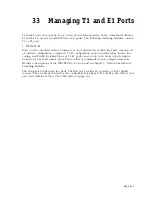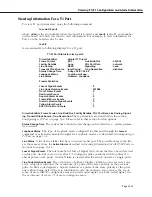
Configuring an E1 Port
Page 33-9
2) Frame Format
Specify the E1 frame format to be used on this port. The choices are as follows:
E1
Standard E1 frame format using the framing bits in time slot 0 for framing.
E1-CRC
E1 frame using framing bits in both time slot 0 and
CRC-4
multiframe for fram-
ing.
E1-MF
E1 frame using framing bits in both time slot 0 and time slot 16 multiframe for
framing.
E1-CRC-MF
E1 frame using framing bits in time slot 0, time slot 16 multiframe, and
CRC-4
multiframe for framing.
unframed
The framing software will not look for framing bits to determine the start of a
frame or multiframe. Data is treated as a data stream. When used in a circuit
emulation application, this option should be chosen when configuring an
“unstructured” circuit emulation service.
Important Note
You
cannot
use the unframed format on WAN
modules.
3) Not FAS
Indicates whether you want to add an extra level of frame checking. E1 frames in time slot 0
are composed of alternating bits of
FAS
(Frame containing Frame Alignment Signal) and
NFAS
(Frame not containing Frame Alignment Signal). The
Not FAS
option tells the framer to check
framing on
FAS
and
NFAS
bits. Normally, the framer checks only
FAS
bits, which contain the
frame alignment signal pattern. If you enable
Not FAS
, then framing software will additionally
also check
NFAS
bits, which include remote alarm indication information.
4) Line Build Out
The
E1
port supports short haul or long haul interfaces. Only
E1
ports equipped with a Line
Interface Unit (
LIU
) chip support long haul. Long haul support is necessary if this E1 port is
directly connected to a Central Office (i.e., not connected via an external CSU) and the cable
length is greater than 655 feet (200 meters). If this E1 port connects locally using less than 665
feet (200 meters) of cable, then short haul is adequate.
Note
All T1/E1 ports are equipped with a Line Interface Unit
(
LIU
) chip.
An additional prompt displays requesting the resistance type used for this port connection.
40) Cable Type
Indicate the cable resistance type used on the short or long haul interface. The cable resis-
tance type can be 75 ohm or 120 ohm. The resistance is a set via a jumper on the E1
board; it is not configurable through software.
5) Line Coding
The type of physical encoding used on the connection.
AMI
(Alternate Mark Inversion) is
more sensitive.
HDB3
(High Density Bipolar 3) should be used when possible.
Summary of Contents for Omni Switch/Router
Page 1: ...Part No 060166 10 Rev C March 2005 Omni Switch Router User Manual Release 4 5 www alcatel com ...
Page 4: ...page iv ...
Page 110: ...WAN Modules Page 3 40 ...
Page 156: ...UI Table Filtering Using Search and Filter Commands Page 4 46 ...
Page 164: ...Using ZMODEM Page 5 8 ...
Page 186: ...Displaying and Setting the Swap State Page 6 22 ...
Page 202: ...Creating a New File System Page 7 16 ...
Page 270: ...Displaying Secure Access Entries in the MPM Log Page 10 14 ...
Page 430: ...OmniChannel Page 15 16 ...
Page 496: ...Configuring Source Route to Transparent Bridging Page 17 48 ...
Page 542: ...Dissimilar LAN Switching Capabilities Page 18 46 ...
Page 646: ...Application Example DHCP Policies Page 20 30 ...
Page 660: ...GMAP Page 21 14 ...
Page 710: ...Viewing the Virtual Interface of Multicast VLANs Page 23 16 ...
Page 722: ...Application Example 5 Page 24 12 ...
Page 788: ...Viewing UDP Relay Statistics Page 26 24 ...
Page 872: ...The WAN Port Software Menu Page 28 46 ...
Page 960: ...Deleting a PPP Entity Page 30 22 ...
Page 978: ...Displaying Link Status Page 31 18 ...
Page 988: ...Displaying ISDN Configuration Entry Status Page 32 10 ...
Page 1024: ...Backup Services Commands Page 34 14 ...
Page 1062: ...Diagnostic Test Cable Schematics Page 36 24 ...
Page 1072: ...Configuring a Switch with an MPX Page A 10 ...
Page 1086: ...Page B 14 ...
Page 1100: ...Page I 14 Index ...
















































